12. DNA damage and repair
1/24
There's no tags or description
Looks like no tags are added yet.
Name | Mastery | Learn | Test | Matching | Spaced |
|---|
No study sessions yet.
25 Terms
double-stranded DNA structure
Name the 3 main components
Name the DNA bases
How many hydrogen bonds between the DNA bases when bonded?
Phosphate group, Pentose sugar (deoxyribose) & Nitrogenous base
Adenine, Thymine, Cytosine, Guanine
A & T have 2 hydrogen bonds, C & G have 3 hydrogen bonds
Genome stability
How many cells are you roughly made up of?
How many DNA damage events can an individual cell experience per day?
When does DNA damage start?
32 trillion cells
An individual cell can experience up to 1 million DNA damage events per day.
DNA damage begins from the moment you were a single cell and is constantly happening.
Common types of DNA damage
Name 4 examples of sequence changes.
Structural changes include localised structural changes and large structural changes, name the examples for each of these (3).
Name the consequences of these changes (1st consequence has 3 types, 2nd consequence is 3 related forms of alteration to bases)?
Sequence changes
Reactive oxygen species
Thymine dimers
Deamination
Depurination
Structural changes
Localised structural changes
Single strand breaks
Double strand breaks
Large structural changes
Chromosomal rearrangements e.g. translocations
Consequences
Point mutations
Silent (different DNA sequence but same amino acid)
Missense (different amino acid results)
Nonsense (forms premature stop codon)
Insertions/deletions/duplications
Reactive Oxygen Damage
What is reactive oxygen damage?
What can ROS be generated by?
What do ROS react with and what does this do to it?
What can ROS also attack and cause?
Under oxidative stress conditions, excessive ROS can damage cellular proteins, lipids and DNA, leading to fatal lesions in the cell that contribute to carcinogenesis.
Can be byproducts of cellular metabolism or generated by radiation exposure.
Reactive oxygen species (ROS) react with DNA bases, changing their chemistry (oxidised bases) and disrupting base pairing.
Can also attack the DNA backbone, causing breaks.
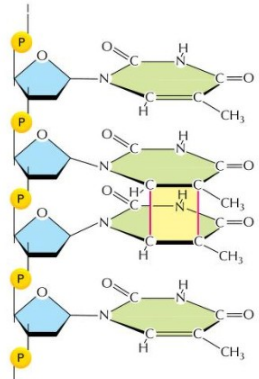
Thymine Dimers
What are thymine dimers?
What type of bond is formed?
What do thymine dimers inhibit?
A covalently bonded complex of two adjacent thymines on a single strand of DNA.
Covalent.
Inhibits DNA replication.
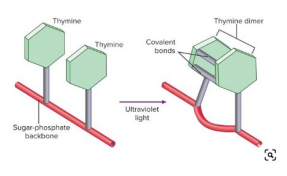
Deamination
What is deamination?
The removal of an amino group from a molecule.
The loss of the amine (NH2) group from cytosine bases
Changes to Uracil (U) – not found in DNA
100 bases per cell per day
Affects DNA replication
Polymerase can mistake uracil for thymidine (T)
Causes and G-A switch in the new sequence (incorrect)
Can be repaired via base excision repair (BER)

Depurination
What is depurination?
How many bases are lost per cell per day by depurination?
What are the bases removed from?
What does depurination consequently cause a loss of and what does it decrease?
What can depurination be repaired by?
Process in which the purine base of a DNA molecule is lost - spontaneous loss of adenine or guanine bases.
5000 bases lost per cell per day.
Become removed from the DNA backbone.
Causes a loss of genetic information, decreases stability in this region – generally not good.
Can be repaired via base excision repair (BER)
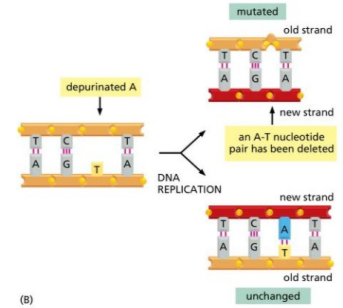
Single strand breaks (SSBs)
What type of structural change are SSBs?
What can they be caused by?
What are they common for?
What do they interfere with?
Are they difficult to repair and how are they repaired?
What can they develop into if not repaired?
Localised structural change.
Naturally occur during many forms of DNA repair (e.g. BER) and can also be caused by other factors.
One of the most common lesions in cells .
Interferes with DNA replication and transcription.
Easily repaired by the cell, using a range of different SSB repair pathways.
Can develop into more severe damage if not repaired efficiently - E.g. become a double strand break.

Double strand breaks (DSBs)
What type of structural change are SSBs?
How are they caused (3)?
How serious are they?
What often happens as a result of DSBs (2)?
What response is triggered?
How are DSBs primarily repaired (2)?
What can happen if DSBs are not resolved?
Localised structural change.
Caused by:
Ionizing radiation and carcinogens can directly break the DNA backbone on both strands.
Can be caused by unresolved stalled replication forks.
Also occur naturally during meiosis and recombination.
Very serious.
Results of DSBs:
Cell cycle is often arrested, disrupting replication/transcription.
Can lead to large genome rearrangements .
A significant DNA damage response is triggered .
Repaired primarily through non-homologous end joining (NHEJ) or homologous recombination (HR).
If not resolved, normally triggers apoptosis - If significant, can impact tissue function.

Large structural changes
Failure to repair DSBs properly can cause large chromosomal abnormalities
Or improper telomere regulation
Deletion of entire chromosome regions or translocations
This is where DSBs at different genomic sites are incorrectly joined together
Causes genomic regions to be in the incorrect place
E.g. t(9;22) translocation, also known as the Philadelphia chromosome
Causes many problems..
Sequence changes
Damage or incorrect repair can lead to point mutations
Silent (different DNA sequence but same amino acid)
Missense (different amino acid results)
Nonsense (forms premature stop codon - PTC)

Sequence changes
DNA also experiences insertions/deletions/duplications
Nucleotides are gained or lost from a sequence
Causes a frameshift
Can cause STOP codons to be abnormally present
Can disrupt the whole sequence (frameshift)
Or add additional information
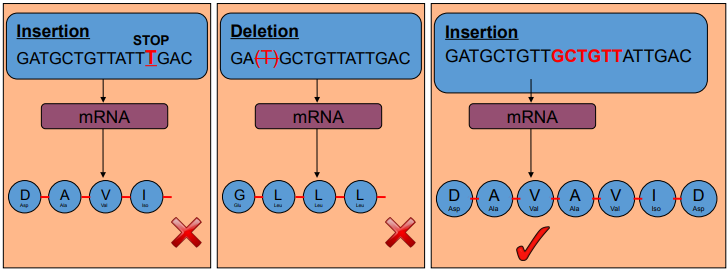
Mutations in disease
Genome instability and unresolved damage lead to mutations
Mutations in coding regions of the genome lead to altered protein function •
Can cause a loss of function
Can cause abnormal gain and functions (dominant negatives) - proliferation signals
Disrupts normal cellular physiology and pathways
Leads to abnormal cellular function and disease
Mutations that cause disease are classed as pathogenic, Mutations may have no effect are classed as benign
Mutation and genetic variation however are drivers of evolution
Mutations in disease
Genome instability and the accumulation of mutations in even one cell can lead to disease.
Some diseases can be caused by a single nucleotide mutation.
E.g. Sickle cell disease
Single A>T change
Some require multiple mutations.
E.g. Cancer (Leukaemia)
Mutations can make cells more susceptible to genomic instability.
E.g mutation in a DNA repair gene..leads therefore to more mutations
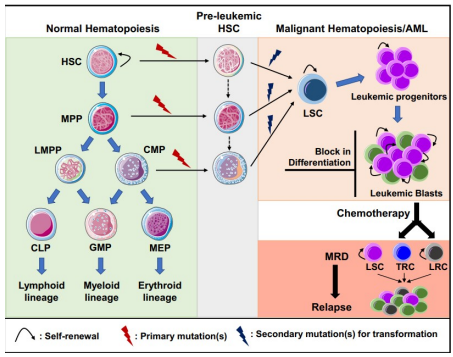
Q. What causes DNA damage and mutations?
Q. Damage type and extent differs by cell type – why?
Sources of genome instability
Name 8 Exogenous sources (From outside the cell) of genome instability.
Non-ionising radiation (UV)
Ionising radiation (X-ray, gamma rays etc)
Thermal damage (burns)
Alkylating agents (tobacco smoke, chemicals)
Chemotherapy drugs (Cisplatin)
Viruses (Influenza virus A2/HK/68)
Plant/fungal toxins (Aflatoxins)
Excess hormones (Oestrogen HRT)
Sources of genome instability
Name 7 Endogenous sources (From inside the cell) of genome instability.
Replication errors (Fork collapse, metaphase issues, synthesis mistakes)
Complex DNA structures (Hairpins/repetitive sequences/ RNA hybrids)
Reactive oxygen species(metabolism products)
Depurination (loss of A and G bases)
Deamination (C to U conversion)
Telomere shortening (End replication problem)
Deficient DNA damage response (incorrect DNA repair)
Radiation is all around us
Non-ionising radiation
Ultraviolet radiation
Normal UV (UVA and UVB) exposure can cause 100,000 DNA damage events per day
Is the primary cause of skin cancer
UV radiation can form a covalent link between neighbouring thymines
Forms thymine dimers
Interferes with DNA replication and transcription
Usually quickly repaired by base or nucleotide excision repair
Ionising radiation
Ionising radiation is energy released from the disintegration of atoms
Travels as waves (gamma or X-rays)
Or as particles (Alpha, beta or neutrons)
Differ greatly in their energy, range of travel and ability to penetrate materials
Gamma rays vs X-rays
What energy are they both made of?
What can gamma rays easily penetrate?
What can gamma rays completely pass through?
How damaging are gamma rays?
How do X-Rays compare in energy to gamma rays?
?
?
What scan also uses X-Rays?
Both made of pure energy (photons)
Gamma Rays
Easily penetrate skin and clothing
Can completely pass through the body
Extremely damaging!
X-Rays
Lower energy than gamma rays
Can include DNA breaks
Cells repair most of this
CT scans also use X-rays
Ionising radiation
What can ionising radiation directly damage?
What are the 2 examples of this damage?
How does radiation do this?
What does it cause?
What can ionising radiation generate?
What is the example of what ionising radiation can generate?
How does it generate this product?
How does this product damage DNA?
How serious is ionising radiation?
Ionising radiation can directly damage DNA
Double strand breaks (DSBs)
Single strand breaks (SSBs)
Energy from radiation breaks covalent bonds
A loss of DNA bases
Or generate products that are able to damage DNA
Generate reactive oxygen species (ROS)
Through hydrolysis of water
Reactive particles attack DNA
Very serious effects and difficult to repair.
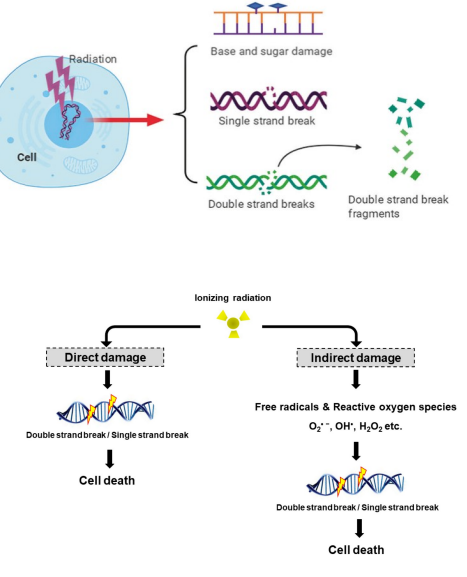
Environmental ionising radiation exposure
On average people are exposed to about 2.7 millisieverts (mSv) of ionising radiation per year (e.g in x-rays, flights, brazil nuts, e.t.c).
Radon Gas
Formed from uranium found in rocks and released from the ground
Can be alpha, beta or gamma particles
UK average dose is 1.3mSv
(Cornwall average dose is 6.9mSv)
~1000 lung cancer deaths nationally attributed to Radon
Homes may needed to be protected from the ground
Dont panic…
Average = 2.7 mSv of radiation per year
Annual limit for nuclear industry employees = 20mSv
Level where white cell changes can be observed = 100mSv
Radiation sickness (<50% white blood cell count) = 1000mSv
Dose required to kill 50% of people exposed = 5000mSv
Hisashi Ouchi - received 17 sieverts (17,000mSv)
Radiation in research
We use radiation a lot in research to cause DNA damage, mutations and understand cancer
32P-ATP, 3H
Tightly controlled
Chemically induced DNA damage
Name 5 examples of chemicals which can induce DNA damage.
Asbestos - can lead to oxidative DNA damage
Pesticides - organophosphates and organochlorines (ROS)
Mycotoxins - can crosslink DNA or form adducts (bind to DNA)
Tobacco smoke - can crosslink DNA or form adducts (bind to DNA) + contain ROS
Chemotherapy drugs - e.g Cisplatin crosslinks purine bases to form intrastrand adducts. Disrupts DNA structure and interferes with DNA metabolism
Endogenous sources